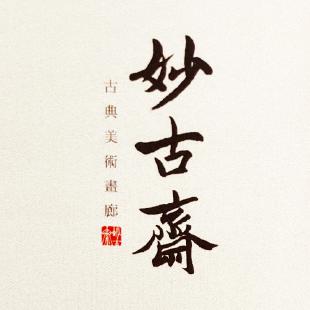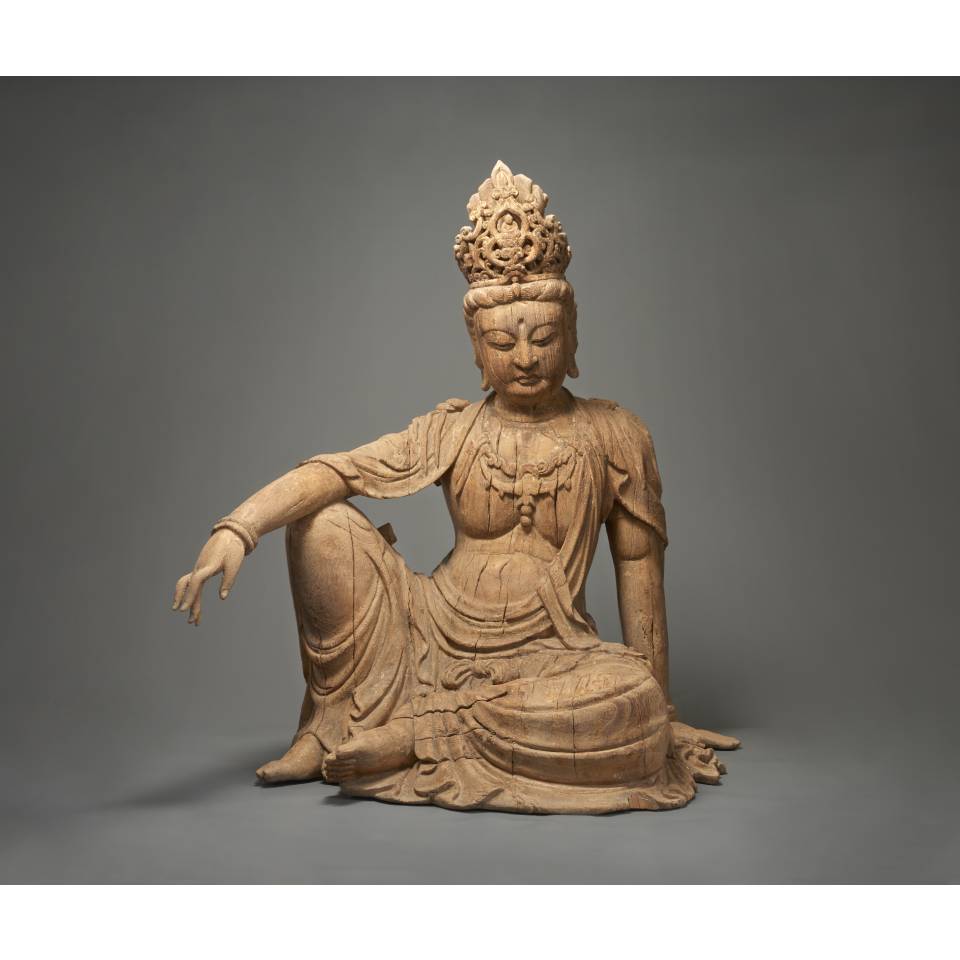Offered By

妙古齋古典美術畫廊
台灣,台北市
-
《法華經觀世音菩薩普門品》載「若有無量百千萬億眾生,受諸苦腦,聞是觀世音菩薩,一心稱名,觀世音菩薩即時觀其音聲,皆得解脫⋯⋯以是因緣名觀世音」。
觀世音菩薩,古佛再來,《千手千眼大悲心經記載「此觀世音菩薩,不可思議威神之力,已於過去無量劫中已作佛竟,號正法明如來,大悲願力為欲發起一切菩薩安樂成熟諸眾生故,現作菩薩」。
佛教自漢代東傳入中原,經千年發展演變,已成中華文明中非常重要的一種哲學思想,而隨之發展的佛教美術,在中國則掀起波瀾壯闊的浪濤,是中國美術史上璀璨的明珠。後秦時期,鳩摩羅什將法華經譯成中文後,觀世音菩薩之信仰便開始大範圍流行中國,唐朝時期普門品的流傳已經非常普遍。其時唐人為避太宗李世民之名諱,故只稱觀音,後世遂沿用至今。
自在觀音之造像風格源自中唐時期畫家周昉所創,《歷代名畫記》卷十稱「周昉字景元,官至宣州長史,初效張萱畫,後則小異,頗極風姿。全法衣冠,不近閭里,衣裳勁簡,彩色柔麗,菩薩端嚴,妙創水月觀音之體」。從敦煌和山西中晚唐的佛造像中可以明顯看到這種典型。
宋代經濟繁榮,佛教更深入民間,從藝術中反映當時社會的審美喜好,遼、宋、金時期的佛造像已有別於隨朝的拙樸厚重和唐代的婀娜多姿,呈現的是端莊典雅和閒然自適的虔靜之感。
高雅飄逸與肅穆無華的氣韻使的宋、遼、金時期的佛造像,在佛教雕朔史上,有其特殊的時代定位,而一句「無宋木不成館」更是說明了宋、遼、金時期木雕佛造像在藝術收藏圈的地位。
~觀自在菩薩,行深般若波羅蜜多時,照見五蘊皆空,度一切苦厄~
Guanyin wood sculpture with color paintings: Song Dynasty
《The Wonderful Dharma Lotus Flower Sutra Chapter Twenty-five, "The Universal Door of Gwan Shr Yin Bodhisattva”》said: "if all the countless hundreds of thousands of millions of living beings tormented by misery and pain hear of Gwan Shr Yin Bodhisattva, and with all their hearts invoke his name, Gwan Shr Yin Bodhisattva will immediately respond to their prayers and set them free.”
GuanShiYin Bodhisattva returns from the ancient Buddha. According to 《The great compassion Sutra》: this GuanShiYin Bodhisattva has an incredible power of God, and has become a Buddha from numerous disasters in the past.
The great compassion is willing to initiate all Bodhisattvas for the desire, and become Bodhisattvas for the happiness and satiable all beings.
Buddhism was introduced into the Central Plains from the east of the Han Dynasty. After thousands of years of development and evolution, it has become a very important philosophy in Chinese civilization. The Buddhist art, which has developed with it, has set off a great wave in China and is a bright pearl in the history of Chinese art.
In the later Qin Dynasty, after kumarashi translated the Sutra of fa-hua into Chinese, the belief of Avalokitesvara began to be popular in China in a large scale. The popularity of the popular items in Tang Dynasty was very common. At that time, the Tang Dynasty only called Guanyin for avoiding the name of Emperor Taizhong, Li Shi Min. Later generations have continued to use it.
The image style of Guanyin originated from Zhou Fang, a painter in the middle Tang Dynasty. He was appraised as such in volume 10 of 《The Famous Paintings OF All Dynasties》: He served as the governor of Xuanzhou, and imitated Zhang Xuan's paintings in the early stage, but later his painting style was quite different and more elegant,he is not close to the countryside, with simple clothes and soft colors. The style of Shui Yue Guanyin created by him is very ingenious, and Bodhisattva's face is solemn. It can be seen from the Buddha statues of Dunhuang and Shanxi in the middle and late Tang Dynasty.
In Song Dynasty, with economic prosperity, Buddhism went deeper into the folk, reflecting the aesthetic preferences of the society at that time from art. The Buddhist statues in Liao, Song and Jin Dynasties are different from those in Sui Dynasty and Tang Dynasty. They present a sense of modesty, elegance, leisure and self-adaptive.
In the history of Buddhist sculpture, the statues of Buddhism in Song, Liao and Jin Dynasties, which were made by elegant and solemn charm, had its special orientation of the times, and a sentence "if there is no wood sculpture from Song Dynasty, it can not be called a museum" showed the position of the statues of wood Buddha in the art collection circle in Song, Liao and Jin Dynasties.
The Bodhisattva Avalokiteshvara, while dwelling in the deep Perfection of Wisdom, sees clearly that the Five Skandia’s are all empty and is thus free from all suffering.

